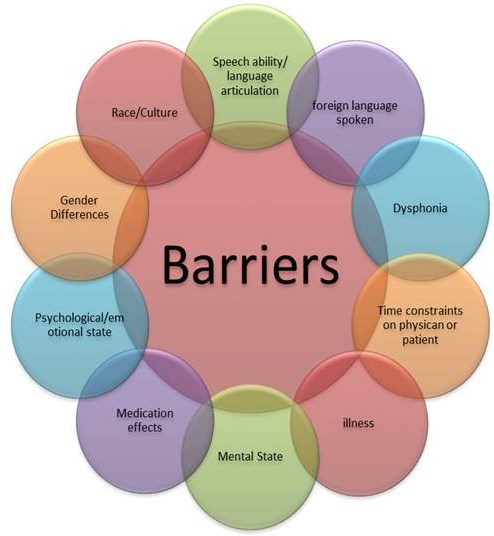What are the Barriers to Effective Health Communication?
Barriers to effective health communication include language barriers and lack of health literacy. Effective health communication is hindered by differences in languages and the ability to understand health information.
Additionally, low health literacy levels further limit the effectiveness of health communication efforts. Ensuring effective communication in healthcare requires addressing these barriers and finding solutions to bridge the gap between healthcare providers and patients. By addressing language barriers and improving health literacy, healthcare professionals can enhance communication and promote better patient outcomes.
The Impact Of Communication On Healthcare Outcomes
Effective communication plays a crucial role in improving healthcare outcomes. When healthcare professionals and patients are able to communicate clearly and effectively, it leads to a number of benefits for both parties. From improving healthcare access and utilization to enhancing patient satisfaction and engagement, and reducing health disparities, effective communication has a profound impact on the overall quality of healthcare delivery.
Improving healthcare access and utilization
Clear and effective communication is essential for improving healthcare access and utilization. When healthcare professionals provide accurate information about available healthcare services and how to access them, patients are more likely to seek appropriate care. By breaking down communication barriers, healthcare providers can ensure that patients understand the importance of preventive care, treatment options, and how to navigate the healthcare system effectively.
Enhancing patient satisfaction and engagement
Effective communication also plays a vital role in enhancing patient satisfaction and engagement. When healthcare professionals actively listen and communicate empathetically, patients feel heard and understood. This leads to stronger patient-provider relationships and increased trust, which in turn leads to better patient adherence to treatment plans and improved health outcomes. Additionally, clear communication ensures that patients are well-informed about their condition, treatment options, and what to expect, empowering them to actively participate in their own care.
Reducing health disparities, ensuring equitable care
Another important aspect of effective communication in healthcare is its role in reducing health disparities and ensuring equitable care for all patients. When healthcare providers possess cultural competency and are able to communicate effectively with diverse populations, they can better understand and address the unique needs and challenges faced by different communities. This helps to bridge the gap in healthcare disparities and ensures that all patients receive the same level of care, regardless of their background or circumstances.
In conclusion, communication is a powerful tool in healthcare that impacts various aspects of patient care and outcomes. By improving healthcare access and utilization, enhancing patient satisfaction and engagement, and reducing health disparities, effective communication has the potential to transform the healthcare landscape and create positive change.
Identifying Barriers To Effective Health Communication
When it comes to effective health communication, there are several barriers that can hinder the transfer of information between healthcare providers and patients. Identifying these barriers is essential in order to overcome them and ensure that patients can make informed decisions about their health.
Language and Cultural Differences
One of the primary barriers to effective health communication is language and cultural differences. In a diverse society, healthcare providers need to communicate with patients from various cultural backgrounds and linguistic abilities. This can lead to misinterpretation or misunderstanding of important health information.
For instance, a doctor might use medical jargon that is unfamiliar to a patient, making it difficult for them to understand their diagnosis or treatment plan. Similarly, cultural differences can affect the perception of health and may influence the acceptance or adherence to medical advice. In such cases, it is crucial for healthcare providers to bridge the gap by using plain language, providing written materials in multiple languages, and being aware of cultural norms and beliefs.
Limited Health Literacy
Another significant barrier to effective health communication is limited health literacy. Health literacy refers to a person’s ability to obtain, process, and understand basic health information. It is estimated that nearly half of all adults in the United States have difficulty understanding and using health information.
Individuals with limited health literacy may struggle to comprehend medical instructions, navigate the healthcare system, or make informed decisions about their health. This can lead to poor health outcomes and increased healthcare costs. To overcome this barrier, healthcare providers should use simple and clear language, provide visual aids or multimedia resources, and encourage patients to ask questions to ensure comprehension.
Lack of Trust in Healthcare Providers
A lack of trust in healthcare providers can severely impede effective health communication. Building trust is critical for patients to feel comfortable discussing their symptoms, concerns, and treatment options openly. Without trust, patients may be less likely to follow medical advice or disclose important information that could help with accurate diagnosis and treatment.
In order to establish trust, healthcare providers should actively listen to their patients, demonstrate empathy and respect, and provide evidence-based information in a transparent manner. It is also important to address any potential biases or misconceptions that patients may have, and involve them in shared decision-making to foster a sense of partnership in their healthcare journey.
In conclusion, identifying barriers to effective health communication is essential for healthcare providers to improve patient education, enhance treatment outcomes, and promote overall well-being. Language and cultural differences, limited health literacy, and the lack of trust in healthcare providers are three notable barriers that must be addressed through clear and culturally sensitive communication strategies.
Importance Of Addressing Language Barriers
Effective health communication is essential for providing quality healthcare services to diverse populations. However, language barriers can significantly impede the communication process, leading to potential negative consequences on healthcare outcomes.
Language barriers and healthcare outcomes
Language barriers can have a profound impact on healthcare outcomes. Without effective communication, healthcare providers may struggle to understand patients’ needs, symptoms, and medical histories accurately. As a result, diagnosis and treatment decisions may be compromised, leading to potential errors and suboptimal outcomes.
To address this issue, it is crucial for healthcare organizations to prioritize language accessibility and ensure that language services are readily available to patients with limited English proficiency. By doing so, they can bridge the communication gap and improve the overall quality of care provided to diverse populations.
Ensuring accurate and clear communication
When it comes to addressing language barriers, it is vital to ensure accurate and clear communication between patients and healthcare providers. This involves various strategies, including the following:
- Providing professional interpreters or language services: Healthcare organizations should invest in professional interpreters who can facilitate effective communication between patients and healthcare providers. This ensures that all parties involved understand each other’s messages accurately.
- Using plain language and avoiding jargon: Healthcare professionals should communicate information in a clear and understandable manner, avoiding complex medical terminology and jargon. By using plain language, patients can easily comprehend their conditions, treatment plans, and medication instructions.
- Using visual aids and written materials: Visual aids, such as diagrams, charts, and illustrations, can enhance understanding, especially for patients with limited language proficiency. Providing written materials in the patient’s preferred language can also assist in reinforcing the communicated information.
By implementing these strategies and ensuring accurate and clear communication, healthcare organizations can overcome language barriers and improve health outcomes for all patients.
Overcoming Language Barriers
Overcoming Language Barriers
In effective health communication, language barriers can often hinder the understanding and accessibility of important information. Communicating complex medical concepts can be challenging, especially when dealing with individuals who have limited proficiency in the dominant language. However, there are several strategies that can be employed to overcome these language barriers and ensure that important health information reaches everyone in a clear and understandable manner.
Utilizing professional interpreters
One of the most effective ways to overcome language barriers in health communication is by utilizing professional interpreters. These individuals are trained to provide accurate and culturally sensitive interpretation services, ensuring that both the healthcare provider and patient understand each other clearly. By having an interpreter present during consultations, medical procedures, and discussions, healthcare professionals can ensure that accurate information is exchanged, and questions or concerns are addressed effectively. This not only promotes understanding but also helps foster trust and a stronger patient-provider relationship.
Offering translated materials and resources
Another key strategy for overcoming language barriers is by offering translated materials and resources. This includes translating important health documents, such as patient forms, discharge instructions, and medication labels, into languages commonly spoken by the local population. By providing these materials in languages that individuals understand, healthcare organizations can empower patients to make informed decisions about their health and ensure they have access to critical information. Additionally, offering translated resources like pamphlets, brochures, and websites can further enhance health literacy and improve overall health outcomes.
Providing language assistance services
Lastly, healthcare organizations can overcome language barriers by providing language assistance services. This includes offering language helplines, where individuals can call and receive assistance in their preferred language. It also involves training healthcare staff to utilize basic communication techniques to bridge communication gaps, such as the use of visual aids, simple language, and gestures. By ensuring that language assistance services are readily available, healthcare organizations can ensure that individuals with limited language proficiency receive the support they need to understand and actively participate in their healthcare.
Cultural Factors Impacting Health Communication
Effective health communication is a crucial aspect of providing high-quality healthcare. It allows healthcare providers to deliver important information, navigate cultural nuances, and establish trust and rapport with their patients. However, cultural factors can often act as barriers to effective health communication. Understanding and addressing these cultural factors is essential to ensure that healthcare messages are delivered comprehensively and effectively to diverse populations.
Recognizing cultural beliefs and practices
One of the key cultural factors impacting health communication is the need to recognize and understand the diverse cultural beliefs and practices of different communities. Individuals belonging to different cultural backgrounds may have unique beliefs about health, illness, and healthcare. These beliefs may influence their understanding of medical advice, treatment options, and preventive measures.
Healthcare providers need to recognize and validate these cultural beliefs and practices to effectively communicate with their patients. By taking the time to understand their patients’ cultural perspectives, healthcare providers can tailor their communication strategies to resonate with their patients’ values and beliefs. This can help bridge the gap between different cultural perspectives and ensure that health messages are understood in the intended manner.
Cultural sensitivity and competency in healthcare
To overcome the barriers posed by cultural factors, healthcare providers should also strive to develop cultural sensitivity and competency in their interactions with patients. Cultural sensitivity involves being aware of and respecting cultural differences without judgment or prejudice. Cultural competency, on the other hand, goes beyond awareness and includes the ability to effectively communicate and provide healthcare services that are aligned with the cultural values and preferences of individual patients.
By incorporating cultural sensitivity and competency into their practice, healthcare providers can create an inclusive and culturally responsive healthcare environment. This can help establish trust and open lines of communication with patients from diverse cultural backgrounds. It allows for more effective health communication, as patients feel understood, respected, and empowered to actively participate in their own healthcare decisions.
In conclusion, cultural factors play a significant role in health communication. Recognizing cultural beliefs and practices and developing cultural sensitivity and competency are essential steps to overcome these barriers. By addressing cultural factors and tailoring health communication strategies accordingly, healthcare providers can improve patient outcomes and promote equitable access to healthcare for all.

Credit: publichealth.tulane.edu
Understanding Health Literacy
Understanding health literacy is a crucial component in effective health communication. Health literacy refers to an individual’s ability to understand and use health information to make informed decisions and take appropriate actions to maintain or improve their health. It goes beyond basic reading and writing skills, encompassing the capacity to find, evaluate, and apply health-related information. Recognizing the definition and importance of health literacy is vital in overcoming barriers to effective health communication.
Definition and Importance of Health Literacy
Health literacy is a fundamental aspect of health communication that empowers individuals to actively participate in their own healthcare. It involves not only understanding medical terminology and instructions but also interpreting numerical data, discerning between credible sources, and effectively communicating with healthcare professionals. The World Health Organization (WHO) defines health literacy as “the cognitive and social skills which determine the motivation and ability of individuals to gain access to, understand and use information in ways that promote and maintain good health.”
Impact of Low Health Literacy on Health Outcomes
A lack of adequate health literacy can significantly impact health outcomes and contribute to health disparities. Individuals with low health literacy may struggle to understand medical advice, leading to confusion about treatment regimens, medication adherence, and preventive measures. This can result in poor self-management and a higher risk of medical errors or complications.
Moreover, low health literacy is associated with increased healthcare costs due to frequent hospitalizations, emergency department visits, and unnecessary tests or procedures. Furthermore, limited health literacy affects not only individuals but also their families and communities, as it can hinder health education and preventive efforts.
Improving health literacy is essential for overcoming barriers to effective health communication and promoting better health outcomes for individuals and communities. By enhancing health literacy, individuals can feel empowered to make informed decisions about their health, understand health information more effectively, and actively engage in their healthcare journey.
Strategies To Improve Health Literacy
Clear and Simple Communication Techniques
One of the key strategies to improve health literacy is to use clear and simple communication techniques. This involves presenting information in a way that is easy to understand for individuals with different literacy levels. Here are some effective techniques:
- Use plain language: Avoid using technical terms and jargon that may confuse the audience. Instead, use simple and everyday language that is familiar to the readers.
- Keep it concise: Present information in a clear and concise manner, avoiding unnecessary details or complicated explanations. Use short sentences and paragraphs to enhance readability.
- Break down complex concepts: When discussing complicated topics, break them down into smaller, more manageable parts. Present each part separately, ensuring that the audience grasps the information step by step.
- Repeat important information: Emphasize critical points by repeating them throughout the communication. This helps reinforce key messages and ensures that they are understood.
Use of Visual Aids and Plain Language
Another effective strategy is to utilize visual aids and plain language in health communication. Visual aids enhance understanding by providing visual representations of information, while plain language helps simplify complex concepts. Here’s how you can incorporate these strategies:
- Use infographics and diagrams: Visual aids such as infographics, diagrams, and charts can aid in conveying information more effectively. They provide a visual representation that is easier for the audience to understand and remember.
- Include relevant images: Incorporating relevant images in your communication can help to capture the reader’s attention and make the content more engaging. Images can also support the text and clarify important points.
- Highlight key information: Use bold or italicized text to highlight important information. This draws attention to critical details and makes it easier for readers to identify key messages.
Tailoring Information to the Audience’s Literacy Level
To effectively improve health literacy, it is essential to tailor information to the audience’s literacy level. Not all individuals have the same level of literacy, so customizing the content ensures that it is accessible to everyone. Here are some ways to achieve this:
- Assess the audience’s literacy level: Before creating health communication material, conduct an assessment or survey to gauge the audience’s literacy level. This will help you understand their needs and preferences, enabling you to customize the information accordingly.
- Use multiple formats and delivery methods: Provide information in various formats such as written material, videos, audio recordings, and interactive tools. This accommodates different learning styles and preferences, making it easier for individuals to access the information.
- Create materials at different literacy levels: Develop materials at different literacy levels, ranging from basic to more advanced. This allows individuals with different reading levels to access information that best suits their needs.
- Offer additional support: Consider providing additional support resources such as glossaries, FAQs, or contact information for further clarification. This ensures that individuals can seek assistance if they have any questions or difficulties understanding the information.
Importance Of Trust In Healthcare
The Importance of Trust in Healthcare
When it comes to effective health communication, trust plays a crucial role in ensuring the success of patient-provider relationships. Trust is not just a vague concept in healthcare; it is the foundation upon which all interactions and communications are built. Without trust, effective communication becomes challenging, hindering the overall quality of healthcare delivery. In this article, we will explore the role of trust in patient-provider relationships and how it acts as a crucial element for effective communication.
Role of Trust in Patient-Provider Relationships
Trust forms the core of any patient-provider relationship. Patients must feel confident in the abilities and intentions of their healthcare providers in order to build a trustworthy relationship. The role of trust goes beyond mere confidence and belief; it affects the way patients interact with their providers and follow their advice.
Building trust begins from the moment a patient walks into a healthcare facility. The first impression plays a vital role in establishing a trusting relationship. Providers who are trustworthy in their knowledge, competency, and interpersonal skills create a solid foundation of trust. This sense of trust will then guide how patients communicate their health concerns, ask questions, and seek clarification during medical encounters.
Furthermore, trust also involves patients feeling that their providers have their best interests at heart. Patients want to feel that their providers genuinely care about their health and well-being. Trust provides patients with the confidence to disclose sensitive information, adhere to treatment plans, and actively engage in shared decision making with their providers.
Trust as a Foundation for Effective Communication
Effective communication in healthcare relies heavily on trust between patients and providers. Trust fosters an environment where patients feel comfortable in expressing their health concerns, discussing treatment options, and sharing their personal experiences. It serves as the catalyst that promotes open and honest conversations, enabling providers to gain a comprehensive understanding of their patients’ needs.
Additionally, trust paves the way for effective information exchange. Patients who trust their providers are more likely to understand and follow medical advice, reducing the chances of misunderstandings or non-compliance. They are more open to discussing their symptoms, concerns, and preferences, which helps providers make accurate diagnoses and develop appropriate treatment plans.
Trust also plays a significant role in patient satisfaction and overall healthcare outcomes. Satisfied patients are more likely to adhere to prescribed treatments, follow preventive measures, and engage in recommended lifestyle changes. Ultimately, this contributes to better health outcomes and improved patient well-being.
In conclusion, trust is the cornerstone of effective health communication and patient-provider relationships. It forms a solid foundation where patients feel comfortable sharing their concerns, asking questions, and actively participating in their healthcare journeys. By prioritizing trust, healthcare providers can foster positive relationships and facilitate effective communication, ultimately improving patient outcomes.
Building Trust With Patients
Building trust with patients is an essential aspect of effective health communication. When patients trust their healthcare providers, they are more likely to actively participate in their own healthcare journey, follow treatment plans, and openly communicate their concerns. However, there are several barriers that can hinder the establishment of trust. This section will explore three key strategies healthcare providers can employ to effectively build trust with their patients.
Establishing Rapport and Empathy
Establishing rapport and empathy with patients is crucial in building trust. Patients want to feel heard, understood, and valued by their healthcare providers. By taking the time to listen actively, showing genuine concern, and displaying empathy towards their patients, healthcare providers can foster a stronger patient-provider relationship.
Healthcare providers can demonstrate empathy by:
- Using open-ended questions to encourage patients to share their thoughts and concerns.
- Using reflective listening techniques, such as paraphrasing and summarizing, to show patients that their concerns have been understood.
- Maintaining eye contact and using positive body language, such as nodding and leaning in slightly, to convey interest and attentiveness.
- Acknowledging and validating patients’ emotions and experiences.
Providing Transparent and Honest Information
Transparency and honesty are key components in building trust with patients. Patients have the right to be informed about their health conditions, treatment options, and potential risks. By providing clear and accurate information, healthcare providers can empower patients to make informed decisions about their healthcare.
Healthcare providers can promote transparency and honesty by:
- Explaining medical terms and procedures in simple language that patients can easily understand.
- Presenting information in a clear and organized manner, using visual aids if necessary.
- Informing patients about the potential benefits, risks, and alternatives of different treatment options.
- Addressing any uncertainties or limitations in the available information and being upfront about the uncertainties.
Addressing Patient Concerns and Expectations
Addressing patient concerns and expectations is vital in building trust and ensuring patient satisfaction. Patients often have worries and fears about their health conditions, treatment outcomes, and the healthcare system as a whole. By actively listening to their concerns and addressing their expectations, healthcare providers can help alleviate anxiety and build trust.
Healthcare providers can address patient concerns and expectations through:
- Allowing patients to ask questions and providing thorough explanations.
- Being transparent about treatment options, including the potential benefits, risks, and limitations.
- Setting realistic expectations and discussing the potential outcomes of treatment.
- Offering reassurance and support throughout the healthcare journey.
In conclusion, building trust with patients is crucial in effective health communication. By establishing rapport and empathy, providing transparent and honest information, and addressing patient concerns and expectations, healthcare providers can foster a trusting and collaborative relationship with their patients.
Frequently Asked Questions
What Are The Barriers For Effective Communication In Health Care?
Barriers to effective healthcare communication include language barriers, lack of clear information, limited health literacy, and technology difficulties.
What Are The 7 Barriers Of Communication?
The 7 barriers of communication are noise, language barriers, lack of attention, physical barriers, cultural differences, emotional barriers, and perception differences.
What Are The Five 5 Barriers To Effective Communication?
The five barriers to effective communication are noise, language barriers, lack of clarity, non-verbal cues, and cultural differences.
What Are The Barriers In Health Communication Explain In Detail?
Barriers in health communication include language barriers, lack of health literacy, cultural differences, and limited access to healthcare services.
Conclusion
Effective health communication can be hindered by various barriers that have been explored in this blog post. From language and literacy barriers to cultural and societal factors, these obstacles can significantly impact the delivery and reception of important health information.
It is crucial for healthcare professionals and organizations to recognize and address these barriers to ensure that valuable health messages reach the intended audience. By adopting strategies such as using plain language, employing culturally sensitive approaches, and utilizing technology, we can overcome these challenges and boost the effectiveness of health communication.
Improved communication can lead to better health outcomes, increased patient satisfaction, and a more informed and empowered population. As we continue to navigate the complex landscape of health communication, it is essential that we remain mindful of these barriers and work towards breaking them down for the benefit of all.



